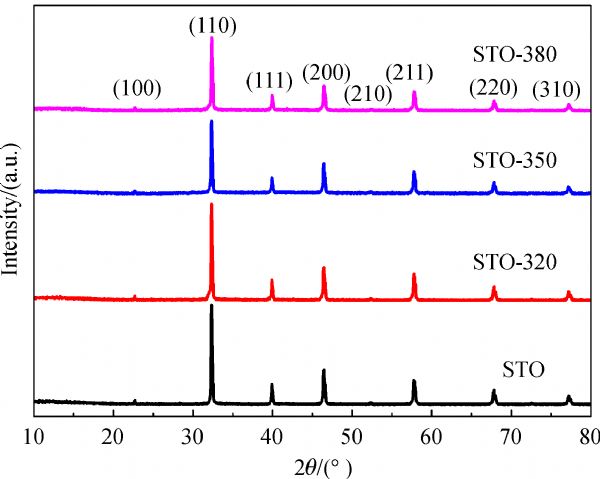

Enhanced photocatalytic water splitting with surface defective SrTiO3 nanocrystals
Received date: 19 Nov 2020
Accepted date: 20 Dec 2020
Published date: 15 Sep 2021
Copyright
Surface reconstructed SrTiO3 nanocrystals were synthesized by a thermal treatment process in presence of NaBH4 and SrTiO3 nanocrystals. The surface reconstruction of SrTiO3 nanocrystals is attributed to the introduction of surface oxygen vacancies or Ti sites (such as Ti3+ and Ti2+) during the hydrogenation treatment process. The light absorption and the charge transfer ability of SrTiO3 nanocrystals are simultaneously enhanced due to surface oxygen vacancies or Ti sites (such as Ti3+ and Ti2+), which are beneficial to photocatalytic water splitting. Meanwhile, these defects also change the redox potential of the photocatalysts. Since there existed a synergistic effect between the three, the ratio of hydrogen to oxygen production was also regulated.

Junying LIU , Zhidong WEI , Wenfeng SHANGGUAN . Enhanced photocatalytic water splitting with surface defective SrTiO3 nanocrystals[J]. Frontiers in Energy, 2021 , 15(3) : 700 -709 . DOI: 10.1007/s11708-021-0735-2
| 1 |
Hong X, Tan J, Zhu H,
|
| 2 |
Liu J, Ke J, Li Y,
|
| 3 |
Hainer A S, Hodgins J S, Sandre V,
|
| 4 |
Fang W, Liu J, Yang D,
|
| 5 |
Zhou C, Shi R, Waterhouse G I,
|
| 6 |
Mao L, Huang Y C, Fu Y,
|
| 7 |
Liu B, Jin Y, Xie G,
|
| 8 |
Desai J, Baviskar P, Hui K,
|
| 9 |
Chen X, Shi R, Chen Q,
|
| 10 |
Chiang T H, Lyu H, Hisatomi T,
|
| 11 |
Wei Y, Wang J, Yu R,
|
| 12 |
Fang W, Qin Z, Liu J,
|
| 13 |
Guo S, Shang J, Zhao T,
|
| 14 |
Macounová K M, Nebel R, Klusáčková M,
|
| 15 |
Duong H P, Mashiyama T, Kobayashi M,
|
| 16 |
Antuch M, Millet P, Iwase A,
|
| 17 |
Zhao Z, Goncalves R V, Barman S K,
|
| 18 |
Ng J, Xu S, Zhang X,
|
| 19 |
Sharma D, Upadhyay S, Satsangi V R,
|
| 20 |
Zhong Y, Ueno K, Mori Y,
|
| 21 |
Jia Y, Shen S, Wang D,
|
| 22 |
Han K, Kreuger T, Mei B,
|
| 23 |
Puangpetch T, Sreethawong T, Chavadej S. Hydrogen production over metal-loaded mesoporous-assembled SrTiO3 nanocrystal photocatalysts: effects of metal type and loading. International Journal of Hydrogen Energy, 2010, 35(13): 6531–6540
|
| 24 |
Mu L, Zhao Y, Li A,
|
| 25 |
Kato H, Kobayashi M, Hara M,
|
| 26 |
Wang B, Shen S, Guo L. SrTiO3 single crystals enclosed with high-indexed {023} facets and {001} facets for photocatalytic hydrogen and oxygen evolution. Applied Catalysis B: Environmental, 2015, 166–167: 320–326
|
| 27 |
Tan H, Zhao Z, Zhu W B,
|
| 28 |
Hu Y H. A highly efficient photocatalyst-hydrogenated black TiO2 for the photocatalytic splitting of water. Angewandte Chemie International Edition, 2012, 51(50): 12410–12412
|
| 29 |
Naldoni A, Allieta M, Santangelo S,
|
| 30 |
Zhao Y, Zhao Y, Shi R,
|
| 31 |
Yu H, Shi R, Zhao Y,
|
| 32 |
Chen X, Liu L, Yu P Y,
|
| 33 |
Wang G, Ling Y, Wang H,
|
| 34 |
Li W, Liu S, Wang S,
|
| 35 |
Koocher N Z, Martirez J M P, Rappe A M. Theoretical model of oxidative adsorption of water on a highly reduced reconstructed oxide surface. Journal of Physical Chemistry Letters, 2014, 5(19): 3408–3414
|
| 36 |
Rabuffetti F A, Kim H S, Enterkin J A,
|
| 37 |
Gu L, Wei H, Peng Z,
|
| 38 |
Hashimoto S, Tanaka A. Alteration of Ti 2p XPS spectrum for titanium oxide by low-energy Ar ion bombardment. Surface and Interface Analysis, 2002, 34(1): 262–265
|
| 39 |
Zhang G, Jiang W, Hua S,
|
| 40 |
Zhang H, Cai J, Wang Y,
|
| 41 |
Shetty S, Sinha S K, Ahmad R,
|
| 42 |
Ning X, Zhen W, Zhang X,
|
/
| 〈 |
|
〉 |